Are you a Quiet Speculation member?
If not, now is a perfect time to join up! Our powerful tools, breaking-news analysis, and exclusive Discord channel will make sure you stay up to date and ahead of the curve.
Last weekend's unbans were met with mixed reactions from the Magic community. I found myself a little conflicted, as well; I generally like shake-ups and "fresh meat," but the back-to-back Pro Tour and GP weekends, which featured incredibly diverse metagames, had just proven Modern to be a format smack in the middle of its golden age.
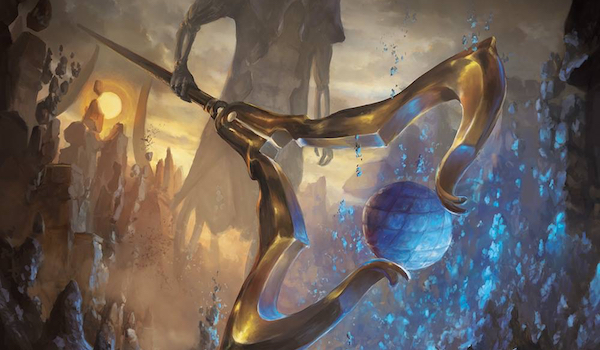
Not one to mope for long, I set out to see just how good the format's new toys really were. But not in their obvious shells, although Kelsey's adoption of Jund some months ago has indeed caused me to get uncomfortably close to Liliana of the Veil. Rather, my head went to the most obvious Johnny shell: a Temur midrange deck featuring Jace, the Mind Sculptor, Bloodbraid Elf, and the recently-unbanned Ancestral Vision. This article sees where the thought experiment brought me and unveils an initial build.
Thinking "Big-Picture"
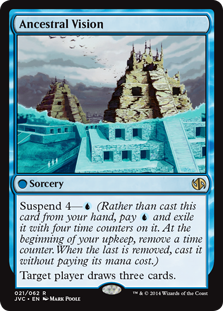
So we want to play Jace, the Mind Sculptor, Bloodbraid Elf, and Ancestral Vision in the same deck. What next? My first step was to think about what these cards do in a typical game of Magic—their effects individually and together, the matchups they shine against, and their respective (or shared) blind spots.
Strengths
Perhaps obviously, Jace, Elf, and Vision all represent two-for-ones, commonly known as card advantage. Jace draws an extra card each turn; Elf finds and casts one; Vision nets us two. Of the three, only Elf provides a tempo gain. Jace incurs the heaviest tempo loss, since it costs four mana and rarely impacts the board to any significant degree. Rather, it's the best spell to cast on an empty or stabilized board.
Synergies
Elf cascading into Vision has never been possible in Modern: the suspend card was banned at the format's outset to prevent Faeries, of all decks, from dominating the competitive scene. But Ancestral Vision does appear to offer the "best" cascade in the format, at least since the rule change that eliminated Elf's once-relevant interaction with Boom // Bust. If that wasn't exciting enough, Jace's Brainstorm ability can put Vision from our hand on top of our deck (perhaps even with an unneeded land above it) for us to cascade into deliberately.
Realistically, though, setting up "draw 3" cascades with Jace rarely comes up. When it does, we're far ahead enough for it not to matter. As such, the three cards in fact offer each other very little. There's no grinding engine inherent to them as with Elf, Liliana, the Last Hope, and Kolaghan's Command, and no major stacking payoff for Brainstorming like Terminus. In fact, Jace's neutral loyalty ability has palpable tension with Blood Moon, a natural compliment to Elf and mana dorks that I think we'd be wrong not to try in this shell; since Moon turns off fetchlands, Brainstorm itself becomes a lame spell to emulate.
Weaknesses

Jace, Elf, and Vision all share one glaring weakness: their speed. All of these cards are turn-four plays. Granted, we can cast Jace or Elf as early as turn three in this deck, but that's not much of a bump; Visions, for its part, won't resolve early unless a fast Elf cascades into it.
A prevailing narrative among those afraid of this unban claims that despite Jace and Elf being "interactive" cards, or ones that are likely to succeed in decks packed with disruption, they hammer other fair decks so hard that the best way to beat them is to cheat the game: go under the midrange decks with linear creature decks like Affinity and Humans, or over them with ramp and combo like Tron and Ad Nauseam. The data David accumulated on both Bloodbraid and Jace somewhat supports this hypothesis. In any case, though, opponents who can afford to ignore "value" are bound to have a better time against the infamous four-drops.
Incidentally, they also enjoy beating up on Ancestral Vision. Modern's linear decks generally want to win on or by turn four, which is when Vision resolves. So the sorcery finds itself with the same trouble as the four-drops: it's really slow.
Plugging the Hole
I don't think the slowness of these three cards is a death knell for our (literally) mythical Temur deck. But we'll have to build it with them firmly in mind. In other words, despite containing Jace, Elf, and Vision, our deck will have to be geared to fight fast creature decks and linear combo, since we've already got game in midrange mirrors by virtue of our powerful top-end.
Here's the build I settled on testing:
Temur Cobra, by Jordan Boisvert
Include Overview
Some of my choices are no doubt a bit surprising, so I'll outline them here.
Fast Mana
The obvious eyebrow-raising card in this deck is Lotus Cobra. The snake's usually used to ramp into five- and six-drops; in this deck, our curve stops at four. So what gives?
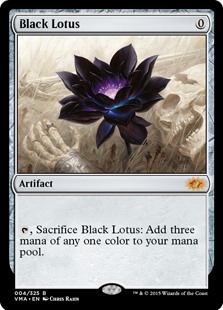 Cobra's a way for us to play Jace or Elf a turn early despite having had our mana dork destroyed on turn one. Especially in the early stages of the coming metagame, I expect spot removal to be at record highs to deal with Elf-featuring midrange decks, like Jund, and go-wide aggro decks that want to get under Jace, like Humans. That means our dorks need life insurance beyond just Tarmogoyf. In a sense, the snake's our Dark Confidant; if it survives a turn, Cobra turns our fetchlands into Black Lotus. We don't even need a fetch to ramp into a four-drop; any mana-producing land will do.
Cobra's a way for us to play Jace or Elf a turn early despite having had our mana dork destroyed on turn one. Especially in the early stages of the coming metagame, I expect spot removal to be at record highs to deal with Elf-featuring midrange decks, like Jund, and go-wide aggro decks that want to get under Jace, like Humans. That means our dorks need life insurance beyond just Tarmogoyf. In a sense, the snake's our Dark Confidant; if it survives a turn, Cobra turns our fetchlands into Black Lotus. We don't even need a fetch to ramp into a four-drop; any mana-producing land will do.
We also have uses for the extra mana. Cobra lets us cast Izzet Charm on our opponent's turn off a single, innocuous fetchland, and makes it easier to cast haymakers through permission. Brainstorm gives us more spells to cast, so Cobra helps double up and ensure our hand doesn't become clogged with top-end threats. Scavenging Ooze makes for a fine mana dump in many matchups, and Raging Ravine fills out the suite by costing an essential five mana to activate and attack.
Between Hierarch and Cobra, this deck packs eight creatures opponents must answer on sight. Failing to deal with Hierarch could mean a turn two Blood Moon, or an equally debilitating play like Bolt-plus-Goyf; meanwhile, turn two Cobra represents up to five mana on turn three. If Hierarch lives and we follow it with Cobra and a fetchland, we can even cast Blood Moon on turn two as well. All these high-priority removal targets make Temur Cobra an ideal home for Tarmogoyf.
Haymakers
 In the mainboard, our primary haymaker is Blood Moon, although Jace and even Goyf count as haymakers in the right matchup. I've found in testing against [mtg_card]Jace, the Mind Sculptor[mtg_card] decks that it's crucial to have a way to punish opponents tapping down for the planeswalker. Against color-heavy Jace shells like Jeskai, Moon fills this role perfectly.
In the mainboard, our primary haymaker is Blood Moon, although Jace and even Goyf count as haymakers in the right matchup. I've found in testing against [mtg_card]Jace, the Mind Sculptor[mtg_card] decks that it's crucial to have a way to punish opponents tapping down for the planeswalker. Against color-heavy Jace shells like Jeskai, Moon fills this role perfectly.
After siding, we gain access to game-breakers like Thrun, the Last Troll, Izzet Staticaster, and Grafdigger's Cage to hate out opponents doing certain things.
Disruption
One major issue with Temur value shells featuring Bloodbraid Elf is their strange relationship with permission. Countermagic is all but necessary in blue-based midrange decks; Karn Liberated outdoes Tarmogoyf every time. We can't always have Blood Moon, after all. But Mana Leak & co. yield dead cascades, a big liability pre-board.
Cryptic Command offers a potential solution, but it doesn't work under Moon and crowds our packed four-drop slot. Besides, we're looking for cheaper options. I've settled on a split between Supreme Will and Izzet Charm, both of which employ a non-permission mode when flipped to cascade. Neither is an exciting cascade hit, of course, but at least they do something. Charm is the better hit of the two since it deals with a small creature across the table, or loots away extra fetchlands. But Will's the preferred counterspell.
Electrolyze joins Izzet Charm as removal for small creature decks. Aggro-combo is immeasurably easier to hate out sans countermagic than spell-based combo, and Electrolyze is a beating for many flavors. It's also a fine cascade hit no matter the board, netting us a card and always doing something else.
Role Players
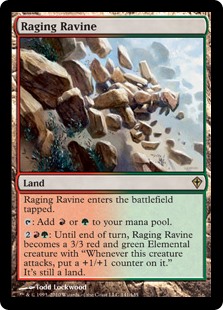 Serum Visions: Serum's a Temur staple that's in kind of a weird spot here. It's a crummy cascade hit, although not truly a "miss," but can also set up cascades in the late-game. I still think it's necessary in some number to smooth our our early-game and grow Goyf past Lightning Bolt, something likely to become more relevant as Jund goes back to 4 Bolt for Elf (besides, Bolt's just great right now in general).
Serum Visions: Serum's a Temur staple that's in kind of a weird spot here. It's a crummy cascade hit, although not truly a "miss," but can also set up cascades in the late-game. I still think it's necessary in some number to smooth our our early-game and grow Goyf past Lightning Bolt, something likely to become more relevant as Jund goes back to 4 Bolt for Elf (besides, Bolt's just great right now in general).- Raging Ravine: I love this card's current positioning. After one attack, it threatens to kill any resolved and ticked-up Jace; in the meantime, it forces Jace to tick up on cast or immediately bite it to the counterless manland. Manlands are also less of a liability with Blood Moon thanks to the Ixalan rules change that lets them enter untapped under the enchantment. It's also nice to have a threat that ignores sweepers like Supreme Verdict; combined with reach, Ravine lets us faux-over-commit to the board only to punish opponents for tapping down to kill all our creatures.
- Scavenging Ooze: Incidental lifegain and graveyard hate, plus a way to hose enemy Goyfs? Sign me up!
- Courser of Kruphix: This card may very well prove too cute in the long run, but I wanted to play it alongside Jace, the Mind Sculptor. It curves into Jace, too, and effectively lets us re-draw the lands in our hand. Courser's a happy cascade hit and grows Goyf in the 'yard. Very possibly, I'll go back to the second Ooze in this slot, but I'll wait to see what Courser's made of first.
Notable Omissions
A couple of otherwise auto-includes for Temur didn't make the cut.
Snapcaster Mage
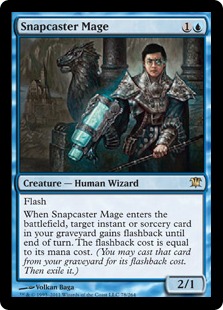 Snapcaster Mage has long been a mainstay in URx strategies, and certainly offers the colors something special: it's a huge end-step play that gives decks extra reach and vastly improves sideboard bullets. Beyond that, Snap's one of the best cards the wedge has when playing from behind on the board.
Snapcaster Mage has long been a mainstay in URx strategies, and certainly offers the colors something special: it's a huge end-step play that gives decks extra reach and vastly improves sideboard bullets. Beyond that, Snap's one of the best cards the wedge has when playing from behind on the board.
Unfortunately, Snapcaster Mage has too much overlap with some other cards in this deck. Bloodbraid Elf is also quite good in a bad spot, if less surgical. The Wizard is also pretty mana-intensive, and less impressive with permission when we're running such clunky counterspells. Perhaps most obviously, since Elf so often requires a tap-out, Snapcaster Mage makes for a frequently awkward cascade hit. To make the most of the 2/1, we'd want to play him alongside enablers like Thought Scour, which also hurt the overall power level of cascade. As it stands, Temur Cobra doesn't play enough instants and sorceries to benefit much from Snap's inclusion.
Huntmaster of the Fells
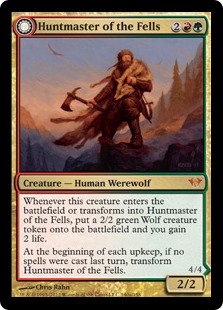 Another major omission from the deck is Huntmaster of the Fells. I've advocated for this card in Temur colors for virtually forever now. It's an engine that wins the game in a matter of turns if opponents fail to answer it, and leaves behind some value if they do. Beyond that, Hunt's one of the few haymakers in Modern that hoses not just attrition strategies, but creature decks—I've won many a game against Collected Company with just the Werewolf. The creature's also eminently castable under Blood Moon and provides incidental lifegain.
Another major omission from the deck is Huntmaster of the Fells. I've advocated for this card in Temur colors for virtually forever now. It's an engine that wins the game in a matter of turns if opponents fail to answer it, and leaves behind some value if they do. Beyond that, Hunt's one of the few haymakers in Modern that hoses not just attrition strategies, but creature decks—I've won many a game against Collected Company with just the Werewolf. The creature's also eminently castable under Blood Moon and provides incidental lifegain.
It's true that small creature decks are the type likely to harass Jace, the Mind Sculptor decks. But we're not your average Jace, the Mind Sculptor deck. Since we've already got heaps of value built into our primary strategy, there are simply more efficient cards to run in our 75 than Huntmaster when it comes to gunning down weenies, such as Pyroclasm.
Bonus Deck: Temur Delver
To be honest, I haven't jammed much with the above Temur Cobra deck. But that's where I'd start with my testing. Some of the deck's issues I encountered in my early testing included removing big threats, especially other Goyfs; this problem can call into question the strength of our value plans and sold me on a Roast in the sideboard. Another fault is the deck sometimes failed to capitalize properly on Blood Moon, which rewards pilots for fronting a lot of pressure.
The other deck these unbans has spurred me to return to is my beloved Temur Delver. Jace, the Mind Sculptor gives it a novel attack plan against the midrange decks that hassle us, and has wowed me in practice. I also just love Moon in this metagame, and Temur Delver wields the card expertly. Here's where I'm at with a list:
Temur Delver, by Jordan Boisvert
This deck's got some new tech in it, too. Basilisk Collar is disgusting with Huntmaster of the Fells and turns all of our creatures into must-remove threats against midrange. Dismember gives us a much-needed mainboard answer to fatties, while Curious Obsession critically grows Mandrills and lets a flipped Delver spot us ferocious. And I've yet to max out Tarmogoyf with this build, but in many post-board games, I do run all eight card types!
Still Chuggin'
The sky might not be falling, after all. If the beautiful, incredibly diverse Modern we had before last weekend's unbans really does get messed up, we can count on Wizards to fix it. They've always released cards from the list during periods of relative stability, and I'm glad they're still experimenting with the format. Now, I'm off for more experimentation of my own!






I like your proposed solution to the BBE + countermagic problem of running Izzet Charm and Supreme Will as your permission spells very elegant. I also think your reasoning for the omission of Snapcaster Mage is sound. However, I’m not a fan of dorks in the shell (as one of the major things you have going for you over a deck like Jund is that your BBEs are better than theirs because you have fewer bad hits), and I’m especially not a fan of Hierarch. I understand that Cobra covers the “mana of any color” base reasonably well, but I think that T1 Birds lets you set up your fetch patterns to line up more optimally with Moon (example: T1 Forest, Birds; T2 Island, Blood Moon), and that has value.
The idea behind Hierarch is that it’s never a truly dead cascade, since it at least pumps a lone swinging Elf that turn. 4 haste damage is enough to come down and immediately kill a ticked-up Liliana, for instance, or a Gideon of the Trials. It also wins us Goyf wars.
Migrated from my Temur moon to your RUG Delver list and have a few questions:
– Why are you using Sleight of Hand instead of Opt, is it to balance the sorcery count for the Goyfs?
– Why are you running Pyroclasm over Rough/Tumble. Does the benefit of killing lingering souls outweigh having a card that kills delver?
Thanks a lot for this sweet list, super fun to play.